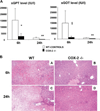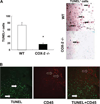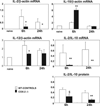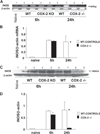Cyclooxygenase-2 deficiency enhances Th2 immune responses and impairs neutrophil recruitment in hepatic ischemia/reperfusion injury
- PMID: 18209082
- PMCID: PMC3589995
- DOI: 10.4049/jimmunol.180.3.1843
Cyclooxygenase-2 deficiency enhances Th2 immune responses and impairs neutrophil recruitment in hepatic ischemia/reperfusion injury
Abstract
Cyclooxygenase-2 (COX-2) is a prostanoid-synthesizing enzyme that is critically implicated in a variety of pathophysiological processes. Using a COX-2-deficient mouse model, we present data that suggest that COX-2 has an active role in liver ischemia/reperfusion (I/R) injury. We demonstrate that COX-2-deficient mice had a significant reduction in liver damage after I/R insult. The inability of COX-2(-/-) to elaborate COX-2 products favored a Th2-type response in these mice. COX-2(-/-) livers after I/R injury showed significantly decreased levels of IL-2, as well as IL-12, a cytokine known to have a central role in Th1 effector cell differentiation. Moreover, such livers expressed enhanced levels of the anti-inflammatory cytokine IL-10, shifting the balance in favor of a Th2 response in COX-2-deficient mice. The lack of COX-2 expression resulted in decreased levels of CXCL2, a neutrophil-activating chemokine, reduced infiltration of MMP-9-positive neutrophils, and impaired late macrophage activation in livers after I/R injury. Additionally, Bcl-2 and Bcl-x(L) were normally expressed in COX-2(-/-) livers after injury, whereas respective wild-type controls were almost depleted of these two inhibitors of cell death. In contrast, caspase-3 activation and TUNEL-positive cells were depressed in COX-2(-/-) livers. Therefore, our data support the concept that COX-2 is involved in the pathogenic events occurring in liver I/R injury. The data also suggest that potential valuable therapeutic approaches in liver I/R injury may result from further studies aimed at identifying specific COX-2-derived prostanoid pathways.
Conflict of interest statement
The authors have no financial conflicts of interest.
Figures













Similar articles
-
Metalloproteinase-9 deficiency protects against hepatic ischemia/reperfusion injury.Hepatology. 2008 Jan;47(1):186-98. doi: 10.1002/hep.21922. Hepatology. 2008. PMID: 17880014
-
Netrin-1 regulates the inflammatory response of neutrophils and macrophages, and suppresses ischemic acute kidney injury by inhibiting COX-2-mediated PGE2 production.Kidney Int. 2013 Jun;83(6):1087-98. doi: 10.1038/ki.2012.423. Epub 2013 Feb 27. Kidney Int. 2013. PMID: 23447066 Free PMC article.
-
Matrix Metalloproteinase-2 (MMP-2) Gene Deletion Enhances MMP-9 Activity, Impairs PARP-1 Degradation, and Exacerbates Hepatic Ischemia and Reperfusion Injury in Mice.PLoS One. 2015 Sep 10;10(9):e0137642. doi: 10.1371/journal.pone.0137642. eCollection 2015. PLoS One. 2015. PMID: 26355684 Free PMC article.
-
Viral interleukin-10 gene transfer prevents liver ischemia-reperfusion injury: Toll-like receptor-4 and heme oxygenase-1 signaling in innate and adaptive immunity.Hum Gene Ther. 2007 Apr;18(4):355-66. doi: 10.1089/hum.2007.181. Hum Gene Ther. 2007. PMID: 17439357
-
Targeting cyclooxygenase-2 in depression is not a viable therapeutic approach and may even aggravate the pathophysiology underpinning depression.Metab Brain Dis. 2012 Dec;27(4):405-13. doi: 10.1007/s11011-012-9326-6. Epub 2012 Jul 7. Metab Brain Dis. 2012. PMID: 22773310 Review.
Cited by
-
Fibronectin-α4β1 interactions in hepatic cold ischemia and reperfusion injury: regulation of MMP-9 and MT1-MMP via the p38 MAPK pathway.Am J Transplant. 2012 Oct;12(10):2689-99. doi: 10.1111/j.1600-6143.2012.04161.x. Epub 2012 Jul 19. Am J Transplant. 2012. PMID: 22812390 Free PMC article.
-
Integrative Analysis of the Roles of lncRNAs and mRNAs in Itaconate-Mediated Protection Against Liver Ischemia-Reperfusion Injury in Mice.J Inflamm Res. 2021 Sep 8;14:4519-4536. doi: 10.2147/JIR.S327467. eCollection 2021. J Inflamm Res. 2021. PMID: 34526799 Free PMC article.
-
Regulation of T helper cell subsets by cyclooxygenases and their metabolites.Prostaglandins Other Lipid Mediat. 2013 Jul-Aug;104-105:74-83. doi: 10.1016/j.prostaglandins.2012.11.002. Epub 2012 Nov 28. Prostaglandins Other Lipid Mediat. 2013. PMID: 23201570 Free PMC article. Review.
-
Protective effect of indomethacin in renal ischemia-reperfusion injury in mice.J Zhejiang Univ Sci B. 2014 Aug;15(8):735-42. doi: 10.1631/jzus.B1300196. J Zhejiang Univ Sci B. 2014. PMID: 25091992 Free PMC article.
-
Cytoprotective effect of prostacyclin on hepatic ischemia-reperfusion injury.World J Methodol. 2025 Dec 20;15(4):104472. doi: 10.5662/wjm.v15.i4.104472. eCollection 2025 Dec 20. World J Methodol. 2025. PMID: 40900847 Review.
References
-
- Howard TK, Klintmalm GB, Cofer JB, Husberg BS, Goldstein RM, Gonwa TA. The influence of preservation injury on rejection in the hepatic transplant recipient. Transplantation. 1990;49:103–107. - PubMed
-
- Jaeschke H, Farhood A, Smith CW. Neutrophils contribute to ischemia/reperfusion injury in rat liver in vivo. FASEB J. 1990;4:3355–3359. - PubMed
-
- Caldwell-Kenkel JC, Currin RT, Tanaka Y, Thurman RG, Lemasters JJ. Kupffer cell activation and endothelial cell damage after storage of rat livers: effects of reperfusion. Hepatology. 1991;13:83–95. - PubMed
-
- Funk CD. Prostaglandins and leukotrienes: advances in eicosanoid biology. Science. 2001;294:1871–1875. - PubMed
-
- Yokoyama C, Tanabe T. Cloning of human gene encoding prostaglandin endoperoxide synthase and primary structure of the enzyme. Biochem. Biophys. Res. Commun. 1989;165:888–894. - PubMed
Publication types
MeSH terms
Substances
Grants and funding
LinkOut - more resources
Full Text Sources
Molecular Biology Databases
Research Materials

